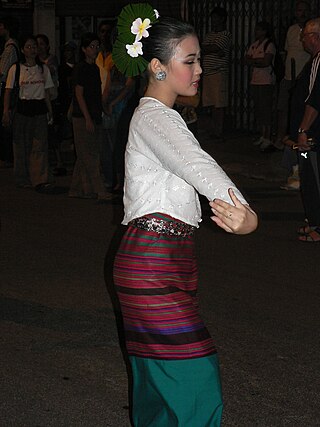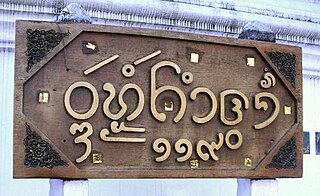

The phin pia is a chest-resonated stick zither with two to five strings. It is considered the national instrument of Northern Thailand.[ citation needed ] The one string version (equivalent to the Cambodian Kse diev) is the phin namtao.


The phin pia is a chest-resonated stick zither with two to five strings. It is considered the national instrument of Northern Thailand.[ citation needed ] The one string version (equivalent to the Cambodian Kse diev) is the phin namtao.

The Mon are an ethnic group who inhabit Lower Myanmar's Mon State, Kayin State, Kayah State, Tanintharyi Region, Bago Region, the Irrawaddy Delta, and several areas in Thailand. The native language is Mon, which belongs to the Monic branch of the Mon-Khmer language family and shares a common origin with the Nyah Kur language, which is spoken by the people of the same name that live in Northeastern Thailand. A number of languages in Mainland Southeast Asia are influenced by the Mon language, which is also in turn influenced by those languages.

The Lao Kingdom of Lan Xang Hom Khao existed as a unified kingdom from 1353 to 1707.

The Northern Thai people or Tai Yuan, self-designation khon mu(e)ang are a Tai ethnic group, native to nine provinces in Northern Thailand, principally in the area of the former kingdom of Lan Na. As a Tai group, they are closely related to Tai Lü and Tai Khün with regards to common culture, language and history as well as to Thailand's dominant Thai ethnic group. There are approximately 6 million Tai Yuan. Most of them live in Northern Thailand, with a small minority 29,442 living across the border in Bokeo Province of Laos. Their language is called Northern Thai, Lanna or Kham Mueang.

Chiang Mai, sometimes written as Chiengmai or Chiangmai, is the largest city in northern Thailand, the capital of Chiang Mai province and the second largest city in Thailand. It is 700 km (435 mi) north of Bangkok in a mountainous region called the Thai highlands and has a population of 1.2 million people as of 2022, which is more than 66 percent of the total population of Chiang Mai province.

Lampang is one of Thailand's seventy-six provinces (changwat), lies in upper northern Thailand. The old name of Lampang was Khelang Nakhon.

Thaification, or Thai-ization, is the process by which people of different cultural and ethnic origins living in Thailand become assimilated to the dominant culture of Thailand, that of central Thailand.

Thai Chinese, Thais of Chinese origin are Chinese descendants in Thailand. Thai Chinese are the largest minority group in the country and the largest overseas Chinese community in the world with a population of approximately 7-10 million people, accounting for 11–14% of the total population of the country as of 2012. It is also the oldest and most prominently integrated overseas Chinese community, with a history dating back to the 1100s. Slightly more than half of the ethnic Chinese population in Thailand trace their ancestry to Chaoshan. This is evidenced by the prevalence of the Teochew dialect among the Chinese community in Thailand as well as other Chinese languages.The term as commonly understood signifies those whose ancestors immigrated to Thailand before 1949.

Jinghong is a city in and the seat of Xishuangbanna Dai Autonomous Prefecture, in the far south of China's Yunnan province, and the historic capital of the former Tai kingdom of Sipsongpanna.

Thai Nation Party, or Chart Thai Party was a conservative political party in Thailand. It was dissolved by the Constitutional Court of Thailand on December 2, 2008, along with the People's Power Party and the Neutral Democratic Party, for having violated electoral laws in the 2007 Thai general election. Thereafter, most MPs founded the Chartthaipattana Party, which became the Thai Nation Party's successor.

Thai people, Central Thai people or Siamese, T(h)ai Noi people, in a narrow sense, are a Tai ethnic group dominant in Central and Southern Thailand. Part of the larger Tai ethno-linguistic group native to Southeast Asia as well as Southern China and Northeast India, Thais speak the Sukhothai languages, which is classified as part of the Kra–Dai family of languages. The majority of Thais are followers of Theravada Buddhism.

Pai is a small town in northern Thailand's Mae Hong Son Province, near the Myanmar border, about 146 km (91 mi) northwest of Chiang Mai on the northern route to Mae Hong Son. It lies on the Pai River. The town has thesaban tambon status and covers parts of the tambon Wiang Tai of Pai District. As of 2006, it had a population of 2,284.
Thailand is a country of some 70 ethnic groups, including at least 24 groups of ethnolinguistically Tai peoples, mainly the Central, Southern, Northeastern, and Northern Thais; 22 groups of Austroasiatic peoples, with substantial populations of Northern Khmer and Kuy; 11 groups speaking Sino-Tibetan languages, with the largest in population being the Karen; 3 groups of Austronesian peoples, i.e., the Malay, the majority ethnic group in the southernmost three provinces, together with the Moken and Urak Lawoi ; and both groups of Hmong-Mien. Other ethnic groups include longstanding immigrant communities such as the Chinese, Indians and Thai Portuguese.
Traditional Thai musical instruments are the musical instruments used in the traditional and classical music of Thailand. They comprise a wide range of wind, string, and percussion instruments played by both the Thai majority as well as the nation's ethnic minorities.

Tai Tham script is an abugida writing system used mainly for a group of Southwestern Tai languages i.e., Northern Thai, Tai Lü, Khün and Lao; as well as the liturgical languages of Buddhism i.e., Pali and Sanskrit. It is historically known as Tua Tham. In Thailand and Myanmar, the script is often referred to as Lanna script in relation to the historical kingdom of Lan Na situating in the Northern region of modern day Thailand and a part of Shan state in Myanmar. Local people in Northern Thailand also call the script as Tua Mueang in parallel to Kam Mueang, a local name for Northern Thai language. In Laos and Isan region of Thailand, a variation of Tai Tham script, often dubbed Lao Tham, is also known by the locals as To Tham Lao or Yuan script. Tai Tham script is traditionally written on a dried palm leaf as a palm-leaf manuscript.

The Isan people or literally Northeastern people are an ethnic group group native to Northeastern Thailand with an estimated population of about 22 million. Alternative terms for this group are T(h)ai Isan, Thai-Lao, Lao Isan, or Isan Lao. Like Central Thai (Siamese) and Lao, they belong to the linguistic family of Tai peoples.

Nam phrik is a type of Thai spicy chili sauce typical of Thai cuisine. Usual ingredients for nam phrik type sauces are fresh or dry chilies, garlic, shallots, lime juice and often some kind of fish or shrimp paste. In the traditional way of preparing these sauces, the ingredients are pounded together using a mortar and pestle, with either salt or fish sauce added to taste.

Andrew Turton was a British anthropologist who specialised on Thailand and the Tai peoples of Southeast Asia.

The kse diev or khse mhoy is a Cambodian musical bow with a single copper or brass string and a gourd resonator. The resonator is held to the bow with a nylon cord and is open at the other end. The nylon cord holds on the resonator and acts as a loop around the copper string, bringing it to the stick. The nylon loop acts as the nut on a guitar, the place below which the string vibrates and sound begins.